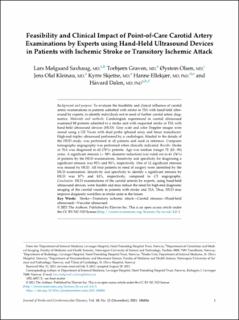| dc.contributor.author | Saxhaug, Lars Mølgaard | |
| dc.contributor.author | Graven, Torbjørn | |
| dc.contributor.author | Olsen, Øystein | |
| dc.contributor.author | Kleinau, Jens Olaf | |
| dc.contributor.author | Skjetne, Kyrre | |
| dc.contributor.author | Ellekjær, Hanne | |
| dc.contributor.author | Dalen, Håvard | |
| dc.date.accessioned | 2022-03-02T09:15:11Z | |
| dc.date.available | 2022-03-02T09:15:11Z | |
| dc.date.created | 2021-09-24T12:26:17Z | |
| dc.date.issued | 2021 | |
| dc.identifier.citation | Journal of Stroke & Cerebrovascular Diseases. 2021, 30:106086 (12), 1-8. | en_US |
| dc.identifier.issn | 1052-3057 | |
| dc.identifier.uri | https://hdl.handle.net/11250/2982332 | |
| dc.description.abstract | Background and purpose: To evaluate the feasibility and clinical influence of carotid artery examinations in patients admitted with stroke or TIA with hand-held ultrasound by experts, to identify individuals not in need of further carotid artery diagnostics. Materials and methods: Cardiologists experienced in carotid ultrasound examined 80 patients admitted to a stroke unit with suspected stroke or TIA with hand-held ultrasound devices (HUD). Grey scale and color Doppler images were stored using a GE Vscan with dual probe (phased array and linear transducer). High-end triplex ultrasound performed by a cardiologist, blinded to the details of the HUD study, was performed in all patients and used as reference. Computer tomography angiography was performed when clinically indicated. Results: Stroke or TIA was diagnosed in 62 (78%) patients. Age was median (range) 72 (2393) years. A significant stenosis (> 50% diameter reduction) was ruled out in 61 (76%) of patients by the HUD examinations. Sensitivity and specificity for diagnosing a significant stenosis was 92% and 93%, respectively. One of 12 significant stenoses was missed by HUD. All four patients in need of surgery were identified by the HUD examination. Sensitivity and specificity to identify a significant stenosis by HUD was 87% and 83%, respectively, compared to CT angiography. Conclusion: HUD examinations of the carotid arteries by experts, using hand-held ultrasound devices, were feasible and may reduce the need for high-end diagnostic imaging of the carotid vessels in patients with stroke and TIA. Thus, HUD may improve diagnostic workflow in stroke units in the future. | en_US |
| dc.language.iso | eng | en_US |
| dc.publisher | Elsevier | en_US |
| dc.rights | Attribution-NonCommercial-NoDerivatives 4.0 Internasjonal | * |
| dc.rights.uri | http://creativecommons.org/licenses/by-nc-nd/4.0/deed.no | * |
| dc.title | Feasibility and clinical impact of point-of-care carotid artery examinations by experts using hand-held ultrasound devices in patients with ischemic stroke or transitory ischemic attack | en_US |
| dc.type | Peer reviewed | en_US |
| dc.type | Journal article | en_US |
| dc.description.version | publishedVersion | en_US |
| dc.source.pagenumber | 1-8 | en_US |
| dc.source.volume | 30:106086 | en_US |
| dc.source.journal | Journal of Stroke & Cerebrovascular Diseases | en_US |
| dc.source.issue | 12 | en_US |
| dc.identifier.doi | 10.1016/j.jstrokecerebrovasdis.2021.106086 | |
| dc.identifier.cristin | 1938169 | |
| dc.relation.project | Norges forskningsråd: 237887 | en_US |
| cristin.ispublished | true | |
| cristin.fulltext | original | |
| cristin.qualitycode | 1 | |

